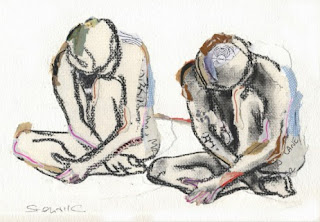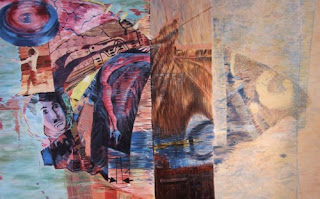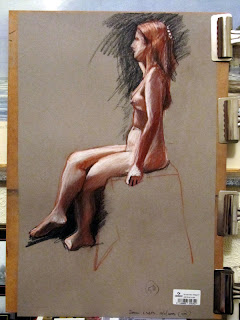I have recently been attending life drawing classes to help me strengthen and develop my drawing skills. I have learnt many techniques since attending these classes which have really made my drawings much more professional and less cartoon and child-like. I can really see the development within my work which really show that taking these classes have really benefited me and my work. I can say that I now look at drawing from another perspective than I did before. I believe this will in the future will benefit my fashion illustrations drawings.
For part of this unit, I have looked at three different artists work to help develop my work and inspire me. The three artists I looked at are Caron Clarke, Stewart Clough and Malcolm Cudmore. Below are my views on their work and the inspiration I have taken from their work to develop my own work.
Caron Clarke
I firstly looked at Caron Clarke, as I found her artwork really inspiring. I liked the media she has used within her pieces as I thought it worked really well and added a lot of depth with the tones she uses. This image above really inspired me as I liked the fact she has used lots of different colours within the image. I like washed-out effect she has given in the background within the image which is something that I would like to achieve within my own work. It looks as if she has used ink or watercolour combined with water for this piece which is really effective. I like the way she has added tone in the image with the light and dark colours she has used. The abstract colours which she has used within this image is really interesting, this is something I would like to experiment with.

This is another image which interested me from her gallery. I like the fact once again she has displayed this washed-out effect in the background once again used what looks like a watercolour medium. This image interested me as she has added tone and depth with the light reflecting from the body and the depth of the shadows in the body. This is something I think I could try concentrating on within my own work. Within the background of the image, she has added an interesting detail which looks like it could be a ladder, I like the way this is muted to the rest of the image.

This image is what attracted me to her work as there is alot of movement within the position of the piece. This also reminded me of the previous artist I looked at within my book research named Bill Buchman; her style within the image is really similar to his but as I looked further into her work I realised her style was really different to his. They both seem to have used the same media but achieve really different outcomes. I like this specific image has it has a really strong outline with the washed-out watercolour effect. I like the way she has played around with composition also as I think this makes the image. I think this is something I could be trying out within my own work.

This final image really interested me as it is more of a portrait style with a really interesting composition. I like the fact she has expressive brush strokes in the background as adds more depth into the image. The tone has display within this portrait is exceptional as you can really tell were the light has hit the models body. This has inspired me to concentrate in this aspect within my own work as i believe before I hadn't put any thought into this before as it hadn't even crossed my mind what effect this could achieve.
I really Caron Clarkes work and it has really inspired me as I have realised what things I have been missing in my previous life drawing classes work. I think looking at her work will really help me develop my own work as I have opened my eyes to how much tone can really effect the image achieving a better overall look. I am also inspired to used ink and watercolour more within my images.
Stewart Clough
I looked into Stewart Clough's work has I was interested in his collage work which had a lot colour within it. Since researching into his work, I found that he did a lot different styles of art work which I could look at to develop a greater understanding of the artists style himself. I was mainly interested and inspired by how he combines collage within his work as I think this looks really effective and makes his work much more interesting.

I like the range of media he has used within the image as I think they all compliment one another. I have noticed that he has not only used collage which has inspired me within my own work but he has also used charcoal which is something I was interested in using myself. I like the way he has produced two of the image positioned in the same way is really effect and looks really interesting. The fact that both of these images are shaded in different ways and tones is also really interesting and looks very effective. I will try using charcoal and collage in my own work.

This image is similar to the image above. I liked this piece as it is very neutral and simple in colour which is something which really drew me to the picture. I like the way the artist has also combined this with the collaging technique which creates a really nice effect and adds more depth and interest in the image. I like the way he has used newspaper in this image to collage and this is something which I would like combine within my own life drawing work. The way the artist has position 3 different poses within one image is something that I would like to do in my own work as I believe this adds more depth into the work and makes it a lot more interest for the final piece.

I looked into the artists work where he has used more colour as well as more collage. I like this images as it is really abstract and interesting. I like the way that the artist has used clashing colours as I think these really thrive off of each other complimenting the overall image. The background has very fascinating brush strokes which I believe make the image have a more messy and rough effective which is something that I believe would work well within my own personal style - this is something that I would try to achieve within my own work.

The image above is another style of work which the artist likes to work within. It is built up by collage. I like the way that he has created 4 different sections also as I believe this makes the piece much more pleasurable to the eye. This adds depth to the image with the tones he has used to create the marks which he has done. I looked into this style he uses as I wanted to see what range the artist has and I shows that he doesn't stick to one style. I will definitely be taking inspiration from this artists work.
Malcolm Cudmore
I looked into Cudmore's work as I liked the fact he uses rough and expressive mark making within his work. The fact that he uses grey backgrounds of Canson pastel paper really interested me as it is more refreshing to see than the usual white canva style background. The way he leaves some of his images unfinished also intrigued me as I like this affect. Cudmore's work is really expressive which is something that really engrossed me into his style although I am not really interested in the real life style and much prefer the colourful styles of the artists before as they are more like my own style of working.
Cudmore usually takes around 10-55 minutes to create most of his pieces which I think is around the same time I have to create my own work as I have a maximum of 30 minutes each pose. I also was interested by the fact that his uses charcoal and chalk within is work as these are mediums which I am interested to work in myself.
The main thing which interested me within Cudmore's work was his interesting brush strokes which is has achieved as I think this really makes the artwork as you can really see his expressive movement. I like the way he has used mainly black and white which is something that I personally like working in although I am not a massive fan of the realistic style within his work as I prefer the more expressive and abstract styles of working. I like the way he has defined the muscles within this image above as this looks really affect.

In this image above you can really see where the light has been caught on the models body as the artist has really focused on reflecting this. I like the way Cudmore has a distinctive outline around the silhouettes of the model, this works well with the light effect. The sketchy expressive background around her torso and feet is really interesting as this looks unfinished but works really well. This is something I would like to play around with and see if it works within my own personal style. The way he is left the stool as a faded outline is really nice and I can relate to this as this is something I have been doing previously within my work. I thought it looked rushed and messy but since looking at Cudmore's work I have changed my views and I believe this could work now.



































